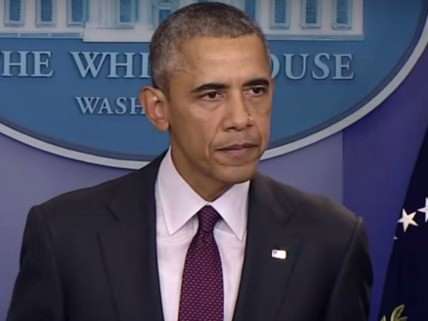Washington Post Fact Checker Calls Obama's Statement About 'Gun Laws' and 'Gun Deaths' Misleading
Talking about mass shootings, the president cited data on suicides.

Responding to last week's massacre at a community college in Oregon, President Obama said "we know that states with the most gun laws tend to have the fewest gun deaths," which according to him means "the notion that gun laws don't work, or just will make it harder for law-abiding citizens and criminals will still get their guns, is not borne out by the evidence." Washington Post fact checker Glenn Kessler gives that statement "two pinnochios," signifying "significant omissions and/or exaggerations." Here's why.
According to the White House, Obama's claim was based on National Journal chart published in August under the headline "The States With the Most Gun Laws See the Fewest Gun-Related Deaths" and the subhead "but there's little appetite to talk about more restrictions." As I noted at the time, that chart included suicides, which account for three-fifths of gun-related deaths in the United States, twice as many as homicides do. You can argue that suicides should be included because gun restrictions might affect them (although Kessler notes that the evidence on that score is equivocal). But in the context of preventing mass shootings, which is what Obama was discussing, it is clearly misleading to cite the association between "gun laws" and "gun deaths" that consist mostly of suicides.
Kessler finds, as I did, that focusing on homicides can have a big impact on a state's ranking:
Alaska, ranked 50th on the National Journal list, moved up to 25th place. Utah, 31st on the list, jumped to 8th place. Hawaii remains in 1st place, but the top six now include Vermont, New Hampshire, South Dakota, Iowa and Maine. Indeed, half of the 10 states with the lowest gun-death rates turn out to be states with less-restrictive gun laws.
Meanwhile, Maryland—a more urban state—fell from 15th place to 45th, even though it has very tough gun laws. Illinois dropped from 11th place to 38th, and New York fell from 3rd to 15th.
National Journal did look at homicides separately, but only with reference to three specific policies regarding carry permits, self-defense, and background checks. Amazingly, those charts omitted the states with the fewest homicides—all of which have relatively permissive gun laws—because they "had too few homicides in 2013 to calculate a reliable rate." By not performing an overall analysis focusing on homicides and by skewing the presentation of data in the ancillary charts, National Journal seemed to be bending over backward to reach the conclusion announced in its headline, including the false implication that correlation proves causation.
"This is a classic situation in which a politician bases a statement on a study, but then exaggerate[s] the conclusions to justify a policy," Kessler writes. "It also lacks context because the results change, sometimes dramatically, when suicides are removed from the gun deaths. While gun suicides are certainly a serious issue— and account for more than 60 percent of gun deaths—the evidence is mixed on whether restricting gun purchases would affect the overall suicide rate. In any case, the president's policy proposals are aimed at mass shootings, not suicides."
[via Hans Bader]


Show Comments (125)